#staller center
Text

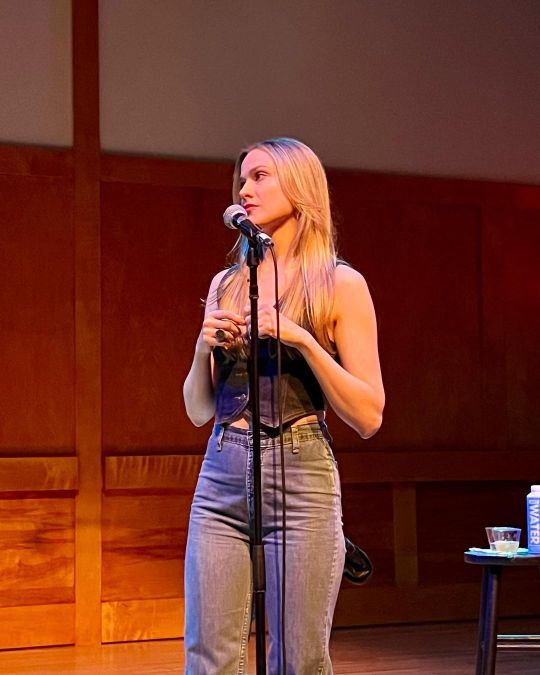
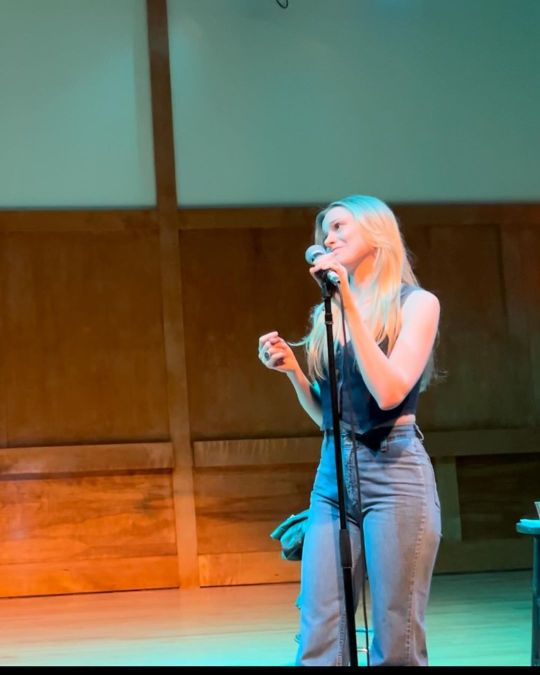



Evan Rachel Wood last night @ Staller Center for Arts performing with @evanandzane.
📷 via: mackenzieelizab3th on Instagram.
#evan rachel wood#evanrachelwood#zane carney#evan and zane#EVAN + ZANE#staller center#stony brook University#show#dream album
13 notes
·
View notes
Note
Would you happen to have recommendations for good, all purpose or simply just worth it 5* operators to raise in Arknights? For someone who has levelled none of them except Amiya, Cantabile, Kroos, Rockeock and Shamare
Going into detail for each and everyone one of them is unfeasible but let's start with the ones I consider really, really good and would always recommend:
Specter - Strong laneholder with self-sustain, best immortality staller in the game for the longest time and still arguably is, benefits from long-term investments in the form of Abyssal Hunter buffs, can be pseudohelidropped with S2M3. Very high HP lets her deals with Arts damage better than in-class equivalents.
Texas - Good DP generator with crowd control and above average damage. Extra starting DP from talent can enable entirely new openers, especially in endgame content. Not exceptional in anything, very reliable in just about any situation to open maps and cover light lanes.
Blue Poison - Strong AA Sniper with constant minibursts and ability to thin lanes thanks to multihits that don't compromise her single targeting, making her a tactical tool that circumvents Taunt to some degree until you can deploy your actual solutions to the Taunt source. Has one of the most famous M3s in her S1, with a charge of 2 attacks.
Warfarin - Versatile unit and easy M6, a lesser known property of her S1 heal is that it is instant, meaning she's a very reliable healer to keep someone under heavy damage alive. Rare Attack Up buff for others, which is what most people know her for. Good SP cycling and can help charge others' SP with her Talent.
Lappland - Best Silence-user in the game, as well as a solid, reliable unit in most maps thanks to her multitarget and Arts damage. You'll hear people claim she's fallen off or some other lie. She is still very solid outside of her Silence (which comes back into relevance every other Thursday anyways).
Ptilopsis - Strong, low investment unit, does not need Masteries at all in order to perform, powerful constant strong heals with S2 and has the best universal Skill Aura Talent that will speed everyone's SP charge by 30% just by existing on the map.
Elysium - One of the best utility units in the game, easy M6 with great SP production, DP reduction and ASPD buffs for Snipers, and a very strong S2 that reveals invisible units, reduces their speed significantly, and gives them a DEF debuff that stacks with other debuffs.
Cantabile - Lightweight assassin that can produce DP per attack while assassinating. Has a short timer to redeploy, so she can be an on-demand miniburst on a troublesome boss or lane, while making DP.
Any of the two Berries, Honeyberry or Mulberry - Handles Elemental Damage buildup, Honeyberry centers more on Elemental Damage, Mulberry has stronger HP heals, both are great. Honeyberry came free with your XBox, no excuse not to raise her. They also have very useful wide ranges that allow for unique safe set-ups.
Projekt Red - Lightweight assassin that can be used as a stunbomb or as a killer for light key targets. Nothing else needs be said, she gets the job done.
Firewatch and Andreana - Heavy duty shooters with wide range and unique targeting rules that specialize in dealing large amounts of damage one way or another, all useful. Firewatch can also use camouflage for fun strats, while Andreana can reap great benefits from long-term investment due to her status as a nominal Abyssal Hunter.
Asbestos - Strong Arts Guard, her S2 can target air, and is just in general very useful in balancing lanes that also need damage when you're spread thin elsewhere, or just as a fun, good unit to use.
La Pluma or Highmore - Both play very similar. Handy, self-sustaining middleweights with potent minibursts and unique three-frontal tile AoE ranges. They can get up to some truly wicked positioning strats.
Manticore - Heavy single hits with either Slow (truly constant with S1M3) or Stun and a large range with true AoE (actually hits EVERY unit in range). Straightforward use and can be used very creatively on chokepoints.
Platinum - S2 gives her extra range and strong single hits, letting her do things no other AA Sniper can do and giving you some ease of command on maps with inconvenient, distant ranged tiles. This is more valuable than you think.
Kazemaru - Middleweight laneholder with explosive bursts and ability to keep herself alive. Can hit air during Doll Form. Allows for various advance deployment strats thanks to her Dollkeeper nature, and has high constant damage during S2 uptime.
Silence - Her drone's healing is actually very powerful, a burst of healing that can actually enable some unique strategies and sustain that you'd otherwise not be able to achieve for cheap. Like her friend Ptilopsis, does not need Masteries to perform at a high level, but of course, welcomes them.
Liskarm - Very sturdy Physical damage tank that can cycle her S1 VERY quickly and has an S2 with good utility for when you need it. Can function as an SP battery for other characters as well, enabling some goofy meme strats (that carry a lot of potency).
Kjera - Great Caster with Freeze on S2. Nothing much needs be said, she's simply lovely, a caster, and can deal good damage with crowd control. Straightforward and simple.
If a 5* isn't here, it doesn't mean they are bad, there are plenty of good ones out there like Iris and Bibeak to name a few, but I consider this list a pretty integral "core" roster, from which you can then expand towards your preferences.
196 notes
·
View notes
Text
Ko-Fi prompt from KemiKitty:
id enjoy hearing about concerts and ticket money if you want
Referencing my “how does this make money/how does this lose money” in this post.
Whoo! I actually really enjoy talking about money flow like this. Digging into examples like this helps with understanding the interconnectedness of the economic systems we inhabit, and with why things cost What They Do.
Disclaimer: I have not worked in this industry. I just majored in business, watch a lot of documentaries/video essays, and like to break down business and economic topics. When I got to performances, I try to figure these things out as an observer (dinner theater from watching Lindsey Sterling before she got super famous, more Traditional concerts at Staller Performing Arts center, Broadway shows) and asking questions of tour guides when at places like the Vienna Opera House.
Our Example: A moderately popular performer, in an enclosed performance space with a stage, fixed seating, and food service.
Let us consider a performer of middling popularity. They go on tours, but only in the lower 48 states, not yet internationally. They do single nights at an independent venue, which has either dinner tables or rows of audience seating. Let's say... 350 seats, in a middle-sized city, with $30/ticket on average, with wiggle room depending on seating, VIP passes, and discounts (groupons, senior, military, annual passes, etc).
So, who is getting paid, and who is paying?
Money coming into the venue, tied directly to this one event:
Tickets
The people who came to this concert are paying for the tickets. 350 seats, at an average of $30/ticket, that's about $10,500. Most of this money does not go to the venue, but may pass through it, or leave a cut with it.
(Depends on the ticketing software; we're saying this is an independent venue, not part of the ticketmaster situation, so it's a maybe.)
Food and drink
The venue sells snacks, possibly full meals, if it's a dinner-and-show location. It may sell alcohol. It almost definitely sells drinks, maybe has vending machines if nothing else. If attendees cannot bring their own food and drink, and don't want to leave the building so they don't miss the show, then the venue can mark up the food they sell.
Merchandise
Dependent on the type of merch and the venue, this may be a flat fee, where the performer puts down a few hundred dollars up front to set up a table for after the concert, or it might be taking a small cut of whatever is sold that night. They might not charge anything, but we'll include it as a likely avenue of income. I can see some kinder venues waiving the fee for newer, up-and-coming artists, but generally you can assume that the venue will take a cut.
Money flowing out of the venue, tied directly to this one event:
The Performer and their team
The ticket costs will go primarily to the performer, their backup dancers/singers/band, their manager, and whatever fund they have for things other than wages, like a tour bus rental fee, the label, the driver, the night's post-concert laundry costs, and so on.
The chances of all that money going to a single performer is very low; you can generally assume they have backup, management, additional costs, and someone pulling the strings. There are exceptions, like unaffiliated stand-up comedians or other, genuinely solo acts, but for the type of event I'm outlining, these are all contributing factors.
Performers may bring their own lighting/sound techs. The venue also might provide their own. For a larger venue, I'd assume both are involved; one who knows the concert's program, and one who knows the venue's setup.
Venue staff
The ushers, lighting/sound technicians, the bar staff, the cook, the janitor, security, and anyone else who is working night-of is getting paid. We can equate their pay to the money coming in from specifically the food and drink sales, along with tips for the waitstaff in particular.
By this, I mean that the correlation is such that, should sales fall, the corresponding cut in costs is employee labor (the bar staff and cooks), rather than the performers (whose costs are calculated in relation to the money they bring in relating to the ticket sales).
Food and Drink
Raw ingredients for the food, wholesale costs for the liquor, napkins, single-use straws, and so on.
Printed Programs
Someone has to print the little booklet that tells you who's performing tonight, who's performing for the next few months, and anything else you need to know. If it's a big-name cultural center, they may even include some interviews! But ink is expensive, and that's a lot of paper.
Money coming into the venue, not connected to the specific event:
Advertising
Does the venue have posters around for local businesses? For insurance companies? For upcoming events? Someone is paying them for that.
Does the venue intersperse the pre-show music over the speakers with the occasional ad spot? Someone is paying them for that.
Does the venue have ads in the program booklet? Someone is paying them for that.
For a really, really large venue, the kind with dozens or hundreds of employees and massive lighting/sound setups, they are liable to get most of their income from advertising.
Government Grants and Private Donations
Depending on the venue, they may donations or grants. This is more likely to apply to a university/community performing arts center than a for-profit dinner theater, but it's a possibility.
Merchandise
The venue may have merch that is unrelated to the performance of the night. A historic or novelty location is most likely to have success with this, selling beer glasses with their logo or a t-shirt with 'home of the [band from several decades ago]' printed across the front.
Money flowing out of the venue, not connected to the specific event:
Administrative/Overhead Employees
Management, bookkeeping, legal, marketing, and so on.
Utilities
Electricity, water, sewage, gas, telecomm, and so on.
Taxes, Licenses, Fees
Sales tax, property tax, liquor license, etc.
Mortgage or lease
The venue's business owner is not necessarily the one to own the property outright. They may pay rent to a property owner, or mortgage to the bank.
Maintenance - Building Codes
Any large building is going to need plumbers, glass techs, electricians, roofers, and so on coming by with regularity.
(This part, I actually do know; I used to do repairs dispatching, and you'd be amazed how frequently a big box store needs someone to come by about the toilets.)
Maintenance - Venue Codes
There are certain things that an entertainment venue needs to do that other businesses... don't. Namely, fire safety. It's a huge deal.
Staying up to code can be expensive, especially if you need to get your backstage/wing curtains chemically treated again, which can be anywhere from one to five years, or the next time someone spills water on it. (That's the main reason open containers of liquids aren't allowed backstage.)
Marketing
Just like people pay the venue to advertise, the venue pays for others to advertise it. This could be in the local newspaper or online, but if a given performer isn't someone semi-famous on tour that has a following, then something else needs to draw in a regular paying crowd.
Miscellaneous Overhead
There is a lot of overhead for any business of moderate size that has its costs spread out over the year. This includes hiring an accountant for tax season, purchasing uniforms for employees, replacing cutlery and plates and furniture as it wears out or gets lost, repainting the walls every few years, office supplies when the printer for the programs wears out, and so on.
Is this everything? Almost definitely not.
But, hopefully, I've untangled a few things that you may not have considered before.
Those tickets and drinks you bought cover a lot more than just the performer!
...unless it's through ticketmaster, in which case it's probably just the monopoly.
----
If you enjoyed this post, please support me on ko-fi! You can also prompt me for a business/econ topic of your choice here.
#business#budgeting#accounting#phoenix posts#ko fi#ko fi prompts#economics prompts#theater fires#are a big deal#this is what accountants do btw. they track all of this plus less concrete stuff like depreciating value or deferred costs
68 notes
·
View notes
Text
youtube
Louis Antoine Dornel - Sonate en Quatuor for 3 violins, cello, and bc
Baroque Sundays at Three. April 22, 2018. Recital Hall, Staller Center for the Arts, Stony Brook University.
2 notes
·
View notes
Text
Gingold Theatrical Group to Present SPEAKERS' CORNER New Play Development Workshops
Featuring: Karma Sutra Chai Tea Latte, Vigil-Aunties, There Goes The Neighborhood, and Howl From Up High.
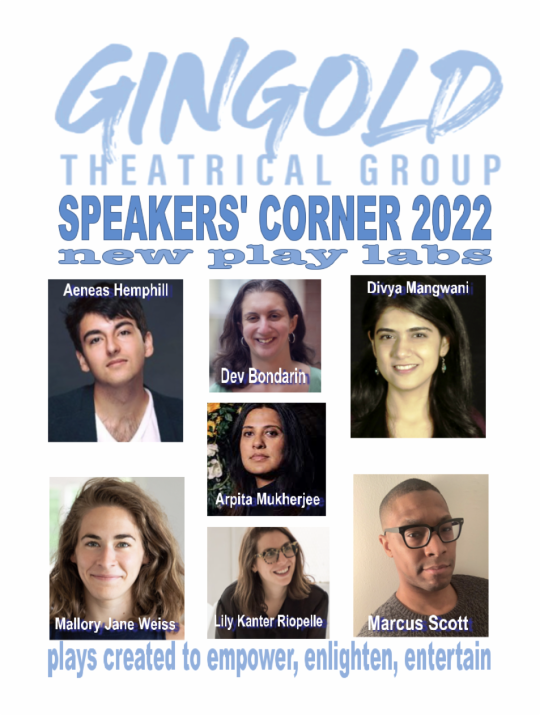
by Chloe Rabinowitz May. 18, 2022
Gingold Theatrical Group, now in its 17th Season, is continuing its new play development with the Plays-In-Progress AEA-approved Showcases of this year's SPEAKER'S CORNER Writers Group. This season, writers Aeneas Sagar Hemphill, Divya Mangwani, Marcus Scott and Mallory Jane Weiss are developing works in response to prompts from the revolutionary activist humanitarian writings and precepts of George Bernard Shaw. These Actors Equity Association approved 29-hour workshops culminate with a presentation as an opportunity for each playwright to assess where they are with their work and to determine the next steps to be taken. These invitation-only presentations will take place at ART-NY Studios (520 8th Avenue). Space for each final presentation is extremely limited and reservations must be made, so to request the opportunity to attend any of these events please email [email protected]
This year's showcases will be:
Howl From Up High
by Mallory Jane Weiss, Directed by Lily Riopelle
Thursday May 19th at 6pm
Purva Bedi, Tori Ernst, Jacqueline Guillen, Sarah Rose Kearns, Adam Langdon, Collin McConnell;
Assistant Director, Margaret Lee
Vigil-Aunties
by Divya Mangwani, Directed by Arpita Mukherjee
Friday May 20th at 7pm
Anya Banerji, Aadya Bedi, Sayali Niranjan Bramhe, Rahoul Roy, Mahima Saigal, Salma Shaw, and Rita Wolf;
Assistant Director, Sara Vishnev
There Goes The Neighborhood
by Marcus Scott, Directed by Dev Bondarin
Friday June 3rd at 7pm
Phillip Burke, Shavanna Calder, Anthony Goss, Ashley Jossell, Olivia Kinter, Monique Robinson, David Rowen, Cliff Sellers;
Stage Manager Elliot J. Cohen.
Karma Sutra Chai Tea Latte
by Aeneas Hemphill, Directed by Arpita Mukherjee,
Monday June 6th at 2pm
Shawn, Jain, Sean Devare, Salma Shaw, Khyati Sehgal, Mahima Saigal;
Stage Manager Elliot J. Cohen
"Among the many programs we've developed over the last 17 years, developing new plays with the intent to produce and publish, has always been the most ambitious dream of all of us at Gingold. While we continue to produce our annual full off-Broadway productions of plays by George Bernard Shaw, we plan to add at least one new play to our schedule to share with our devoted patrons," said David Staller.
Named after the corner of London's Hyde Park where George Bernard Shaw and other political speakers have delivered speeches since 1855, GTG's SPEAKERS' CORNER brings together six to ten writers each year who will spend the year exploring a specific Shaw play and writing individual new plays in response to that text and Shaw's forward thinking humanitarian ideals. Speakers' Corner members meet bi-monthly, and GTG will host showings of the works that Speakers' Corner develops at the end of the season. The group's members were identified through an open application process under the guidance of Becker, GTG Artistic Director David Staller, and this season's Speakers' Corner Readers and Advisory Committee: Ilana Becker, Stephen Brown-Fried, Ralph B. Peña, Daphne Rubin-Vega, Sharon Washington, along with Speakers' Corne alumni Hank Kim, and Lorenzo Roberts.
WRITERS:
Aeneas Sagar Hemphill (he/him) is an Indian-American playwright and screenwriter based in NYC and DC. Weaving through many genres, his work builds new worlds to illuminate our own, investigating the ghosts that haunt our lives and communities with passion, pathos, and humor. He was a 2019 Resident Artist with Monson Arts Center and 2017-2018 Playlab fellow at Pipeline Theatre, as well as semi-finalist for the 2019 Princess Grace Award, semi-finalist for the 2019 Mabou Mines Resident Artist Program, and finalist for the 2017 Many Voices Fellowship. His plays include: Black Hollow (Argo Collective, Dreamscape Theatre), The Troll King (Pipeline), Childhood Songs (Monson Arts), The Republic of Janet & Arthur (Amios), The Red Balloon (Noor Theatre), A Stitch Here or There (DarkHorse Dramatists, Slingshot Theatre), A Horse and a Housecat (Slingshot Theatre). MFA Playwriting, Columbia University.
Divya Mangwani is a writer and theatre artist from Pune, India, based in New York. She examines the absurdities of the social, political and mythical. Her work focuses on global identity and belonging. Divya was the founder and Artistic Director of Moonbeam Factory Theatre, where she wrote, directed, and produced plays in India, Singapore and Glasgow. In New York, she has developed work with UNICEF, Soho Rep, New York Theatre Workshop, Gingold Theatrical Group, Rattlestick Theatre, Mabou Mines, Hypokrit Theatre, The Flea, Project Y, Pipeline Theatre, Rising Sun, and Governors Island. Divya is a recent fellow of the Soho Rep Writer/Director Lab and the Gingold Theatrical Group Speakers Corner and was a NYTW 2050 Artistic Fellow, Hypokrit Theatre Tamasha playwright, Project Y Writers Group and Playlab fellow at Pipeline Theatre. Divya has also worked as a journalist and editor at The Times of India, ESPN, Crisis Response Journal, and Daily News & Analysis.
Marcus Scott is a dramatist & journalist. Selected work includes Tumbleweed (finalist for the 2017 Bay Area Playwrights Festival; semifinalist for the 2022 Eugene O'Neill Theater Center National Playwrights Conference, the 2022 Blue Ink Playwriting Award & the 2017 New Dramatists Princess Grace Fellowship Award), Sibling Rivalries (finalist for the 2021 Seven Devils Playwrights Conference; semi-finalist for the 2022 Lanford Wilson New American Play Festival, the 2021 Blue Ink Playwriting Award & the 2021 New Dramatists Princess Grace Fellowship Award) and Cherry Bomb (recipient of the 2017 Drama League First Stage Artist-In-Residence). He was commissioned by Heartbeat Opera to adapt Beethoven's Fidelio (Librettist/Co-writer; The Met Museum; NY Times Critic's Pick). Recently developed at Gingold Theatrical Group (Speaker's Corner), Zoetic Stage (Finstrom Festival Of New Work), Queens Theatre (New American Voices series) and The Road Theatre Company's Under Construction 3 Playwrights Group and Cohort 2 of the Southern Black Playwrights Lab at the Mojoaa Performing Arts Company. Scott is a 2021 NYSAF Founders' Award finalist and a 2021 Doric Wilson Independent Playwright Award semi-finalist. His articles appeared in Architectural Digest, Time Out New York, American Theatre Magazine, Playbill, Elle, Out, Essence, The Brooklyn Rail, among others. MFA: GMTWP, NYU Tisch.
Mallory Jane Weiss's plays include Big Black Sunhats (The O'Neill National Playwrights Conference 2022; Clubbed Thumb Biennial Commission finalist 2020), Lights Out and Away We Go (Clubbed Thumb reading June 2022), The Page Turners (The O'Neill National Playwrights Conference finalist 2021), Pony Up (Princess Grace Finalist 2019; SPACE on Ryder Farm semi-finalist 2020), Howl From Up High (in development with Gingold Theatrical Group), Evermore Unrest (Red Bull Short New Play Festival 2020), Dave and Julia are stuck in a tree (Playing on Air's James Stevenson Prize 2020), and Losing You, Which Is Enough (workshop readings at The Lark and Cherry Lane Theatre). She is a member of Clubbed Thumb's Early Career Writers' Group (2021-2022), The COOP's Clusterf**k vol. 2 (2021), Gingold Theatrical Group's Speakers Corner, and Fresh Ground Pepper's BRB Retreat (2019). Mallory earned her B.A. from Harvard University and her M.F.A. in playwriting from The New School. She also works as a Senior Writer for Ethena, where she creates harassment-prevention training in the form of short-form articles, graphic novels, audio plays, and more.
In addition to Speakers' Corner, GTG's on-going play development also includes PRESS CUTTINGS, which, in recognition of Shaw's career as a theatre critic, supports the development of new plays written by theatre journalists. Press Cuttings has commissioned new plays by Jeremy McCarter, Robert Simonson, and David Cote, and, in June of 2017, presented an AEA workshop of David Cote's Otherland directed by May Adrales.
This fall, GTG returned to live, in person performance with the acclaimed revival of Bernard Shaw's Mrs. Warren's Profession starring Robert Cuccioli, David Lee Huynh, Alvin Keith, Nicole King, Raphael Nash Thompson, and Tony® Award winner Karen Ziemba as Mrs. Warren, which recently completed its acclaimed Off-Broadway engagement at Theatre Row, directed by David Staller. Terry Teachout, reviewing Mrs. Warren's Profession in The Wall Street Journal, declared "Mr. Staller, who knows everything there is to know about Shaw, has not only staged the play but edited the text with his accustomed skill. All the more reason, then, to praise David Staller, the artistic director of Project Shaw, a long-running series of semi-staged concert readings of the playwright's 60-odd shows. In addition to Project Shaw, Mr. Staller's Gingold Theatrical Group presented fully staged small-scale off-Broadway versions of Heartbreak House in 2018 and Caesar and Cleopatra in 2019, and now they're doing Mrs. Warren's Profession. The production is completely satisfying... Sprinkled with tart, school-of-Wilde epigrams ('There are no secrets better kept than the secrets everybody guesses') and overflowing with glittering talk, it's a foolproof vehicle for six accomplished actors and a director who, like Mr. Staller, knows better than to let the play become a static chat-fest. Instead, he keeps the actors moving and the pace brisk, and the results are immensely pleasurable."
GINGOLD THEATRICAL GROUP creates theater that supports human rights, freedom of speech, and individual liberty using the work of George Bernard Shaw as our guide. All of GTG's programs are inspired by Shaw's humanitarian values. Through full productions, staged readings, new play development, and inner-city educational programs, GTG brings Shavian precepts to audiences and artists across New York, encouraging individuals to breathe Shaw's humanist ideals into their contributions for the future. Shaw created plays to inspire peaceful discussion and activism and that is what GTG aims to accomplish. GTG's past productions include Man and Superman (2012), You Never Can Tell (2013), Major Barbara (2014), Widowers' Houses (2016), Heartbreak House (2018), and Caesar & Cleopatra (2019). Founded in 2006 by David Staller, GTG has carved a permanent niche for the work of George Bernard Shaw within the social and cultural life of New York City, and, through the Project Shaw reading series, made history in 2009 as the first company ever to present performances of every one of Shaw's 65 plays (including full-length works, one-acts and sketches). GTG brings together performers, critics, students, academics and the general public with the opportunity to explore and perform theatrical work inspired by the humanitarian and activist values that Shaw championed. All comedies, these plays boldly exhibit the insight, wit, passion and all-encompassing socio-political focus that distinguished Shaw as one of the most inventive and incisive writers of all time. Through performances, symposiums, new play development, and outreach, as well as through our discussion groups and partnerships with schools including SUNY Stony Brook, Regis, the De La Salle Academy, and The Broome Street Academy, GTG has helped spark a renewed interest in Shaw across the country, and a bold interest in theater as activism. Young people are particularly inspired by Shaw's invocation to challenge the strictures society imposes, to embrace the power of the individual, to make bold personal choices and to take responsibility for these choices. GTG's new play development lab, Speakers' Corner, created to support playwrights inspired by Shaw's ideals, is now in its second cycle. Through monthly prompts and feedback, writers develop work inspired by or in response to a specific Shaw text. Plays developed through Speakers' Corner will be nurtured in workshops and readings with the expectation that GTG will publish or produce them. GTG encourages all people to rejoice in the possibilities of the future. All of GTG's programming is designed to inspire lively discussion and peaceful activism with issues related to human rights, the freedom of speech, and individual liberty. This was the purpose behind all of Shaw's work and why GTG chose him as the guide toward helping create a more tolerant and inclusive world through the exploration of the Arts.
For more information about the Workshops or any of Gingold Theatrical Group's projects, please call 212-355-7823, email [email protected], or visit online at www.gingoldgroup.org.
#Gingold Theatrical Group#GTG#Speakers' Corner#Mallory Jane Weiss#Divya Mangwani#Aeneas Hemphill#Arpita Mukherjee#Lily Riopelle#Dev Bondarin#Marcus Scott#MarcusScott#WriteMarcus#Write Marcus
2 notes
·
View notes
Text
How to Boost Customer Engagement with Professional SEO Services
Digitization has invariably put customer experience at the center of everything. Professional SEO services and digital marketing efforts, today mainly focus on increasing customer engagement by employing different strategies. Customers also have become more demanding and don’t want anything lesser than a staller experience. Pandemic, all over the world in recent days, has also changed the shopping habits of consumers. Consumers are the pampered lots today demanding nothing but the best.
Therefore, any digital marketing agency with serious intent to connect brands with its target audience looks at everything in a renewed light. Thankfully, now businesses have a lot of options to keep their audiences engaged, whether using social media, email, or messaging apps like WhatsApp.

Let us discuss how to improve customer engagement through various methods.
Define brand voice and stick to it
The voice of your brand is its unique personality, the sum total of what your brand stands for. It defines why it is in the market. Most of the time your brand is in the market to resolve some issues that your target audience may be facing. So, your company’s story, its mission, and its vision – all constitute a brand identity and its voice. To boost customer engagement, ensure all your communication channels use a consistent voice that reflects the ideology of your brand.
Personalize Interactions
Generic interaction with your customers feels like noise in terms of ads, email newsletters, and social shares. In today’s scenario, they all just add up to the numbers but seldom bring results. Today customers want a personalized experience, and your communication must reflect that your customers matter to you, and they are not just one among many. Your digital marketing agency should devise a strategy to connect customers with personalized communications with having unique touch.
Helpful and relevant content
There is a saying in digital marketing that your customers don’t buy your products but solutions. The same must be reflected in the content that you share with your target audience. Content should not be some kind of sales pitch, but it should always provide your customers with some critical solutions. It should help solve their problems regarding your product or service. You can create helpful videos, blogs, and social posts and also consider sharing proven tips and practical techniques that your customers may find helpful.
Take a Social approach
The reach and efficacy of social media cannot be ignored in today’s business ecosystem. Social media platforms such as Facebook, Instagram, Twitter, LinkedIn, WhatsApp, etc. have now taken center stage for increasing the visibility of your business and keeping your customers engaged with insightful content. Always include social media strategy in your digital marketing campaigns as through social media platforms you can have direct access to your customer's raw thoughts and feelings.
Collect feedback and address it positively
This process is also called customer relationship management (CRM). Quite simply, your customer’s feedback is the measurement of their satisfaction level. If it is positive, it is safe to assume that your customers got the experience they were looking for. Implement the system of check and balance when it comes to client feedback. Take a proactive approach and ask for feedback from your audience. This sends a signal that you are concerned about your customer experience and helps establish a positive relationship with the customers.
So, these are the basic strategies, any expert digital marketing agency would implement to boost customer engagement. DigiPassel is one such digital marketing agency that offers a host of professional SEO services to increase customer engagement. For more information, contact the experts at DigiPassel.
#digital marketing services#Digital Marketing Strategy#digital marketing solutions#digital marketing agency#DigitalMarketingAgency#Digipassel
1 note
·
View note
Photo

Lightmobile by Eric Staller (1985)
Source: Eric Staller
#lightmobile#eric staller#volkswagen#beetle#new york city#new york#nyc#world trade center#wtc#1980s#80s#80's#1985
364 notes
·
View notes
Photo



'Pfarrzentrum Maria am Wege', parish centre
Windach, Landsberg, Bavaria, Germany; 1968-71
Josef Wiedemann (architect), Blasius Gerg (sculptor), Anton Staller (music organ), Max Raffler (calvary)
see map | more information 1, 2 | pictures
via "Josef Wiedemann Bauten und Projekte"; Meitinger, Otto; TUM (1981)
#architecture#arquitectura#architektur#architettura#parish center#parish centre#church#kirche#igreja#pfarrzentrum maria am wege#josef wiedemann#blasius gerg#anton staller#max raffler#windach#landsberg#bavaria#bayern#deutschland#germany#german architecture
304 notes
·
View notes
Text
Sorting the main cast of AtLA into Hogwarts Houses
I know I’m late to the party because I’ve seen many different people tackle this before, but I feel like it is my civic duty as both a Potterhead and an AtLA stan to put in my two cents, since every single time I’ve seen it talked about people either misinterpret what each House values in their members or pick a House by taking into account only one aspect of their personalities. I want to make it clear that these are my own opinions, which I’m basing on the definitions we’ve gotten of the main traits of each House over the years and the “core values” of each AtLA character, and that I’m in no way am I trying to insult anyone who thinks differently. That being said, here goes nothing!
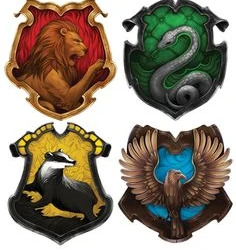
Let’s start with the easy ones. Namely, the Fire Siblings:
1) Azula is 100%, undoubtedly, definitely, incontrovertibly Slytherin. Just doing a quick rundown of the qualities Salazar Slytherin prized in his handpicked students, as stated by the Sorting Hat, Albus Dumbledore and Pottermore: Cunning? Check. Resourcefulness? Check. A disregard for rules? Check. Using any means to achieve her ends? Check. Shrewdness? Check. Ambition? Check. Self-preservation? Check. Pride? Check. An argument could even be made that, as a member of the Fire Nation Royal Family, Azula also kind of meets the “blood purity” criteria. I’m sure most of us agree on this. Even if she does exhibit a lot of loyalty to her father as well as courage and intelligence, there is just no contest. Azula is one of the most Slytherin characters I’ve ever seen outside of the Harry Potter universe.
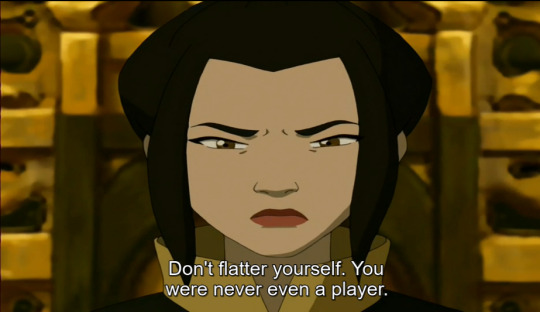
2) In the same way, Zuko is irrefutably a Hufflepuff. Hear me out! I know that he’s very brave and daring, but when we think of Zuko, what is his most essential trait, what do people tell us again

and again

about Zuko’s character?
He’s a hard worker. And what’s the House of the hard-working?
"You might belong in Hufflepuff,
Where they are just and loyal,
Those patient Hufflepuffs are true,
And unafraid of toil.”
You guessed it. Hufflepuff. Of course, that’s not the only trait valued by this House that he exhibits. Who is more loyal in the series than the child who got half his face burned off and still did his best to earn the love and respect of the one responsible? Who never faltered in his loyalty even when he was sent away on an impossible mission? Who spouted angry words most of the time yet was willing to let his ticket home go temporarily in favor of ensuring the safety of his Uncle and his crew? That’s right, our boy Zuko. That very loyalty to his father is what unfortunately bound him for the longest time, until he was forced to face what a monster he was and let go of it in favor of more important things, namely his own morals and his loyalty to his Uncle.
He also has an incredibly strong sense of justice, as proven by the above statements, as well as this moment:

and he can be incredibly patient when he needs to be, as seen during The Blue Spirit and the Southern Raiders episodes.
Hufflepuffs are also said to be fair (which he clearly is), dedicated (need I say more?), honest (which Mr. shouts-his-feelings-at-the-top-of-his-lungs and can’t-lie-without-being-obvious-or-glancing-away-and-has-been-found-out-every-time-he-tried of course is) and modest (this one he starts without but by the time he joins the Gaang there isn’t anyone more modest or humble)
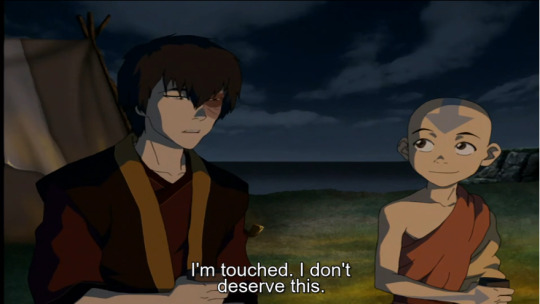
As “an idealist with a pure heart and unquestionable honor” , Zuko is the Hufflepuffiest Hufflepuff to ever Hufflepuff and I will die on this hill
3) Another easy one is our girl Suki, whom I’d say is a Gryffindor through and through, even if she is very loyal to her friends.
The rest of the Gaang under the cut.
The other members of Team Avatar are a bit trickier because they all exhibit a pretty even mix of traits from more than one House, but still if we just concentrate on their defining characteristics we can get to an answer.
4) I’d argue that Sokka belongs in Ravenclaw, even though he is of course quite brave and extremely loyal to his loved ones, not only because he’s a strategist and an inventor, but also because, as best stated by Master Piandao:

Ravenclaws most value wit, learning, intelligence, creativity and wisdom (this last one is a bit iffy but I’m sure he’ll get there when he’s older), as well as priding themselves on being original in their ideas and methods. That’s Sokka to a T.

5) Katara gave me a hard time. She’s unbelievably loyal to her friends and family, she’s compassionate, patient, fair, hard working and dedicated, with a REALLY strong sense of justice, so a case can be made for Hufflepuff easily. However she can also be quite cunning when she wants to (most obviously during The Waterbending Scroll, City of Walls and Secrets, The Painted Lady, and The Runaway), she has a lot of ambition (if you count every variation of “I will make the world a better place by force if I have to”), she disregards the rules when it suits her (again The Waterbending Scroll as well as The Runaway) and she can be proud at times, so we could argue she’s a Slytherin. She’s also undoubtedly very intelligent and even quite wise for her age. It took me a while to decide but then I pondered; at her very core, what are the statements that define her? What words just scream “that’s it, that’s Katara”? They are, of course, these two phrases:

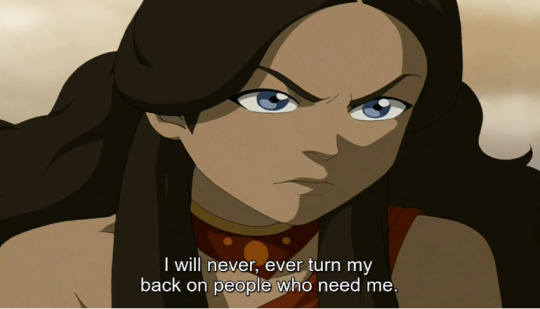
The first sounded incredibly Gryffindor to me, and the second is half Gryffindor half Hufflepuff, so it had to be between those two. As such, I decided to look into Gryffindor first. Katara is, of course, astoundingly courageous, but what else? I had to actually look up definitions for the Gryffindor traits besides courage because they all just kinda meant “brave” to me initially 😅, but what I found was:
*Nerve: “one's steadiness and courage in a demanding situation”. Yep. Who’s the most level-headed, steady and reliable person whenever the Gaang is in any kind of pinch? That’s right. Katara
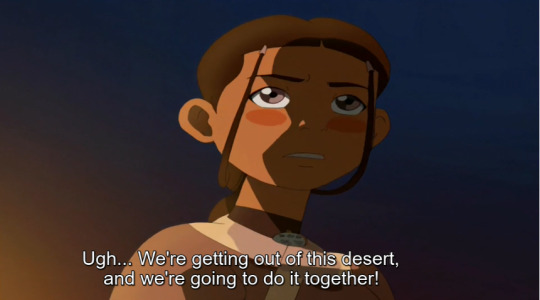
*Daring: “adventurous or audaciously bold“. Yep. I’d say she ties with Toph for boldest in the Gaang
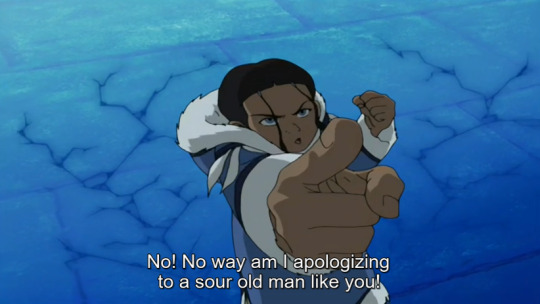
*Determination: “firmness of purpose”. Yep, absolutely. See the above image from the Painted Lady. ‘Nuff said.
*Chivalry: can mean 2 things, one is “sum of the ideal qualifications of a knight, including courtesy, generosity, valor, and dexterity in arms”. All of that is true of her (her “arms” being her waterbending), but I found it interesting that to be chivalrous can also mean “gracious and honorable toward an enemy, especially a defeated one, and toward the weak or poor”. I’d argue that this fits her even more. Once again, just take a look at The Painted Lady episode.
*Courage and bravery: they can mean the same thing, namely “the ability to do something that frightens you” and of course that fits Katara, but the word courage in particular has another meaning, which is “strength in the face of pain or grief”...

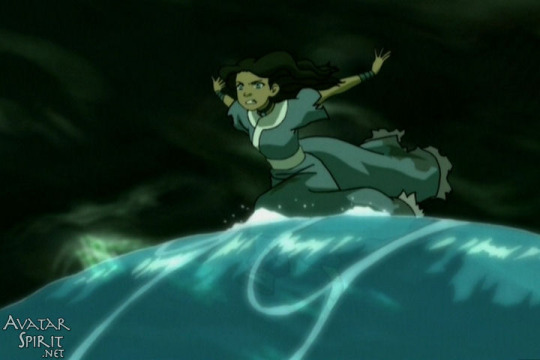
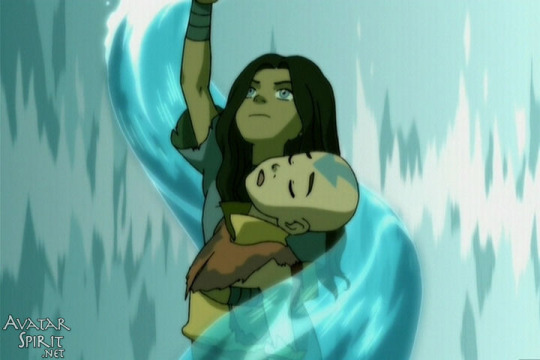
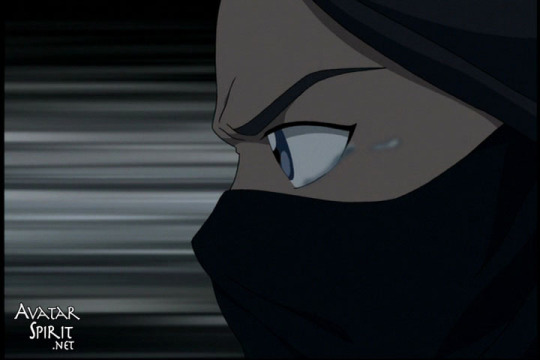


I’d say she’s pretty good at that. I think that settles it, Katara is a Gryffindor.
Turns out that when it came to the water tribe siblings Bato was right all along
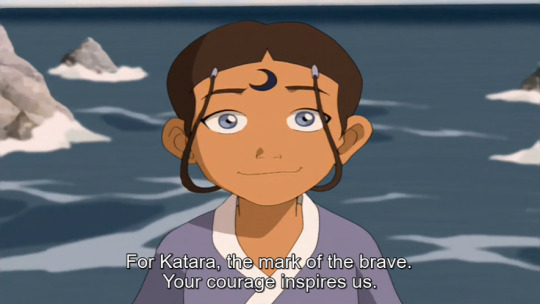
6) For Toph I was split between Gryffindor (thinking of her brash, bold nature) and Slytherin for a while, but after looking into Katara and researching all those definitions I think I have to give it to Slytherin. Of course, Toph doesn’t seem to be very ambitious unless you count “being recognized as the greatest earthbender in the world”, but she is quite cunning. She knows exactly how to use her “poor helpless blind girl” persona to get what she wants, as seen both on The Blind Bandit and The Runaway. She’s also an extremely good actress, being able to play the “reserved and obedient little girl” to her parents for years, and being easily able to pick it back up when it suits her.

She’s also stubborn, proud, and 100% willing to use any means, regardless of laws or rules, to get what she wants.
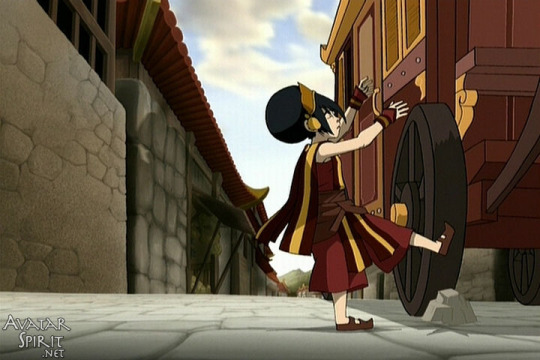
As for self preservation? Remember that her response when asked to teach Aang, which was crucial to save the world but would’ve compromised her secret, was this:

Slytherins can also “hesitate before acting, so as to weigh all possible outcomes before deciding exactly what should be done “ and my first instinct was to say that it didn’t fit Toph at all, but what is Toph if not a person who “waits and listens before striking”? Slytherins tend to favor Neutral Jing it seems.
Almost forgot that as a daughter of the Beifong family she’s sort of nobility and she technically also meets the “blood purity” criteria.
7) Finally, we get to my boy Aang. He was really difficult. He’s loyal, patient, fair, kind, modest (usually) and just but I can’t really call him a hard worker most of the time.
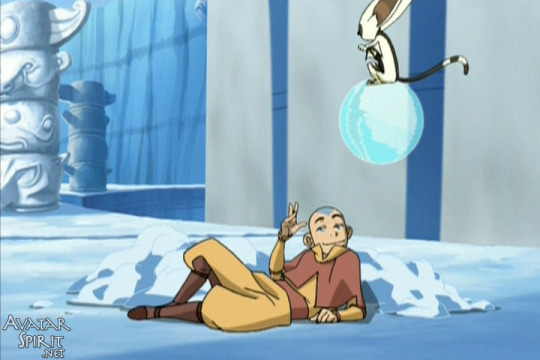

He’s brave, adventurous, determined and chivalrous but he does tend to get discouraged during demanding or stressful situations (his friends always make it better though)

He’s creative, very wise for his age, and quite smart (except when he’s playing around with Sokka in which case they share one brain cell 😂)

He can even be cunning when he needs to be. If he ever went to Hogwarts, he’d definitely be a Hat Staller like Harry. I heard someone say once that they considered Aang a Gryffindor because he liked to show off a lot, but that’s not really a Gryffindor trait (think of Neville Longbottom, Remus Lupin, Harry Potter and Minerva McGonagall. I think any one of them would sooner Stupefy themselves than go show off their skills in front of a crowd for no reason other than to brag).
Once again, we must pin down what it is that defines him, what his core is. After much thought, I decided it’s this:
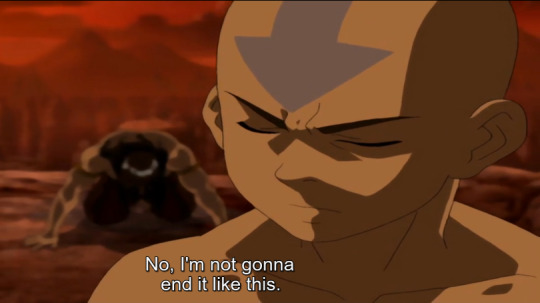
It’s his compassion, which he learned from his people, and his desire to value and protect all life. It’s his loyalty to the ideologies of the Air Nomads of which he is the last remaining bastion. It’s his strong moral code, his sense of right and wrong, his wish to make friends and to believe the best of everyone. That’s his center. That is what makes him Avatar Aang. In light of that, I think we can consider Aang, first and foremost, a Hufflepuff.
In the end, Team Avatar is made up of one Ravenclaw, one Slytherin, one Gryffindor (two after Suki joins), and two Hufflepuffs
Ironic, that the House least valued in the Harry Potter universe is the one that houses arguably the most pivotal characters of Avatar the Last Airbender: Zuko and Aang. Fitting, that even in this they parallel each other.
This is already long enough so I don’t think I’ll do Mai, Ty Lee, or Iroh. Maybe some other time.
#atla#Avatar The Last Airbender#the gaang#fire siblings#team avatar#Zuko#azula#suki#sokka#katara#toph beifong#aang#Harry Potter#hogwarts houses#gryffindor#hufflepuff#ravenclaw#slytherin#thyf rambles#meta#atla meta
196 notes
·
View notes
Text
Allen X Rambles about Chapter 7
“I hope Episode 7 is focused on only 2 or three characters with little distraction... Amiya maybe finding out that Ch’en is slowly becoming Infected and helping her come to terms with that. Ch’en revealing her past to Amiya and the two connecting over losing so many close to them due to Oripathy. The two standing up to the political corruption of Lungmen, shoulder to shoulder, as women that refuse to see another life lost due to the indifference of a city’s politics.”
-Allen X, October 2nd, 2020, Rambling about Chapter 6
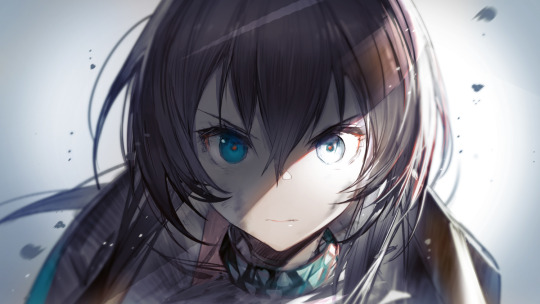
Man... I’m starting to believe it when they say Arknight’s story mode is longer than the Harry Potter series. Things are getting crazy in Chapter 7 and crazy-long to in terms of length. This chapter really had me on the edge of my seat as I read through it and as I played through because 7-16 and 7-18 were a bitch to get through that require some of the most precise timing I’ve seen in this game yet. That aside, I enjoyed a lot what I read and experienced.
And I wanted to talk about it a bit.
But first, as always, a synopsis.
Coming off the heels of Frostnova’s death and the realization of Wei Yenwu’s purging of the Lungmen slums, tensions are high and trust has been fractured between Rhodes Island and Lungmen. However, in the midst of Ch’en hot temper and Amiya’s cool head, Reunion is plans to send the Russian Ursusian city of Chernobog on a collision course with Hong Kong Lungmen, giving Ursus a cause to make war against Lungmen and its great region of Tawain China Yen. However, through some rather amazing political maneuvering and passionate words by Wei Yenwu’s wife Fumizuki, Rhodes Island agrees to mobilize in order to save Lungmen, the Infected, and the beloved daughter of Lungmen, Ch’en. But beyond Chernobog lies Patriot, Reunions greatest commander next to Talulah herself, who’s rage toward his daughter’s death is only matched by his disciplined mind and even more disciplined soldiers. It’s a fight to the center of the Chernobog to save as many lives as possible, even at the cost of this great general’s life.
An Addendum to 7-18
So between my venting about 7-18 when I talked about some fun Arknight’s lore a handful of people wanted to give me some advice on how to conquer that stage. Admittedly that venting was said out of anger and was much more acidic in tone than my usual essays and opinion pieces. I have since beaten that stage and I can give some of my thoughts on this advice. Some of it was helpful... some of it.
“AmIyA cAn TaNk PaTrIoT’s SpEaR tOsS!”
This is technically true and I was technically wrong. When Amiya’s S3 is active she gained increased Max HP and can in fact survive with a sliver of health. However, Amiya’s S3 takes quite a long time to charge even with her talent, and unless someone is actively blocking Patriot her can honestly spam his spear through for how long it takes Amiya to get prepped for her S3. This is more of an issue of Amiya’s balancing than with the game, but I’ll talk about that later.
“jUsT sTaLl PaTrIoT tO kEeP hIm FrOm UsInG tHe SpEaR tOsS!”
This would be pretty viable advice if Patriot didn’t one-shot my units. Yes, defenders like Cuora, Nian, Hoshigumi, and even tankier vanguards like Zima and Siege can tank at least one hit from Patriot without dying, meaning a squad of healers can just focus-fire on them while they do chip damage to Patriot and stall him out. However, Patriot’s phase 2 has him do constant damage to nearby units with his aura ability, so if he can get lucky enough, he take someone down to a sliver and let his poison damage finish off your staller before they get a chance to be healed. That strategy needs luck and some damn smart unit placement. Neither of which I honestly have.
“uSe SpEcTeR aNd DeBuFfErS!”
Again, this is also a pretty good strategy. Specter’s S2 makes her immortal for a limited time and pairing that with healers like Breeze and Celycon who reduce stun damage isn’t a bad idea. Characters that ignore or lower defense like Pramanix, Shamare, and Meteor are also good. This doesn’t work for me however since I only have Pram and the other debuffers are way too underleveled and not on my priority at the moment, and E2-ing units this late in the game just to take out one boss feels like madness.
“f12 CaN dOdGe ThE sPeAr ToSs!”
F12, W, Jessica, and FEater have a dodge chance. Their dodges are not guarantees. Yes, Patriot will target the ranged operator furthest from him and there are range tiles pretty close to his spawn point for that purpose. However, some of those operators have some pretty damn expensive DP costs and waste that on a chance to survive isn’t worth.And feeding Patriot ranged units that take over 30 seconds to redeploy is a waste of DP in general. And those either dodge chances aren’t viable. Them surviving isn’t a strategy, it’s a fluke, and you can’t depend on flukes in auto-deployment.
“Allen, you’re being kind of an asshole to what’s actually sound advice.”
Yes, I am.
I don’t care.
7-18 does things to a person, man. That stage breaks people. I lost sanity IRL just doing that stage or 20 times with a guide... dear lord this stage.
Anyway, moving on.
Story Notes
My, this story sure was thick, wasn’t it? It’s been while since I’ve been on a ride that wild. And this time around I don’t have any small issues to bring up. All the characters felt in character without breaking my suspension of disbelief. There weren’t multiple character arcs going on at once. And I even tolerated Kal’tsit berating the Doctor for reasons beyond his understand since she wasn’t discussing too many things that were above my head as the player.
No... I only have big issues.
But before that, I wanted to hit on some actual important notes that were very good and smartly written.
Rosmontis and Child Soldiers
This was probably the biggest takeaway for me. I know the Arknights community likes to poke a lot of fun about the child soldier thing and how Kal’tsit is harboring slave children, but... man, it makes so much since now.
These kids aren’t just kids, they’re all infected people with some rather scary abilities. Popukar has a history of mental instability coupled with monstrous strength. Ifrit has powers she can just barely keep under control and could set Rhodes Island ablaze at any point. Frostleaf and GreyThroat are deeply traumatized from their past. The Ursus Self Government are full of kids with hatred, resentment, and fear of both the world and themselves. The list goes on, but the fact is that these kids all either have abilities that would be a danger to themselves and others if they aren’t trained, or have emotional hang-ups that might very well have them lash out at innocent people if not put on a leash. Wouldn’t it be better to at least give them some training and let them hack and blast away at the actual bad guys? Wouldn’t it be better to at least make them a weapon for some kind of greater good? And would anyone else really treat these broken, powerful children as anything but weapons and warriors anyway?
I know this is about chapter 7, but I remember in Children of Ursus Rosa asked Zima why she fought, and Zima casually answered that she just liked fighting. It’d be far better to have someone with that mindset working for an organization like Rhodes Island than ending up in Ursus’s fold and blindly hacking at something she shouldn’t.
And I think it’s important to remind everyone that Amiya is the head of Rhodes Island and not Kal’tsit. She’s a big part of the organization, but it’s the bunny in charge. And the bunny that is herself close to a living nuke and is also has empathetic superpowers understands this probably better than anyone else, which is why she okays it.
Patriot and Reunion
As much as I despise, and I do mean despise, how cagey this series can be with it’s portrayal of Reunion’s morality I can understand why a lot of its members can see the group as being just. Patriot is a warrior of such renown and praise, and Talulah has so much charisma and power that I can see the group overlooking characters like Mephisto and W when the other two do so much for their members and general people. The Guerillas under Patriot behave like soldiers. They don’t rampage, loot, pillage, or harm everyone in sight, only those that halt, stagnant, and harm the infect. Talulah has a charisma about her and attracts people, and seems to come from some sort of royal/noble line to match. And while Faust wasn’t mentioned much in this chapter, he was a soldier that started at the bottom, worked his way to the top, and made sure to play by rules that kept his moral high ground. Mephisto seems to be the only outliner here for some baffling reason.
But... there are some major issues with this story. I hint at them every time I talk about Arknights’ story, but I’ll go into depth here. And I’ll present these two issues I have in the form of a two question:
Who is the Doctor?
I don’t mean this the sense of the story, but what is his function as a character? Is he a self-insert for the player, or his own character to be explored and examined?
And either answer, to me, is wrong.
The Doctor Isn’t a Self-Insert
It’s straight up impossible for the Doctor to be a self-insert character. Most self-inserts are blank enough to let us place our own personality onto them and the situations their in the choices they make are meant to be more or less choices we’d make or at least a general audience could make barring some specifics. Their personalities tend to be blank or at least bland to let us, the players, live through them and project our personalities onto them.
The Doctor isn’t this.
There are too many moment where our choices are clearly pointing to one conclusion and most choices, though varied, give a clear idea that the Doctor is someone that care about the operators’ wellbeing deeply and hates seeing them used, abused, or manipulated. They are strategist and commander, but they have enough humanity to not see people as tools. They are passionate when they see other operators and especially Amiya in harms way and tries to come up with strategies to minimize lost and causalities. Awhile we, the player, feel the same in this regard the Doctor has dialogue that feels more conversational and toward specific directions than what a player would likely want and gives us some bits and piece about what they’re actually like.
The Doctor hates Kal’tsit and wants little to do with her, only tolerating her presence as much as she is with the Doctor. The Doctor is a bit of a bleeding heart that doesn’t fully grasp that they are constantly in a warzone despite their strategic competency. The Doctor has an extremely weird diet and eating style, devouring live animals and ingesting foods that would probably need to be probably mixed and brewed before consumption. The Doctor still sees Amiya as a child despite her mature nature.
The list goes on, but there’s enough there for me to say the Doctor is more like Hakuno Kishinami of the Fate/Extra series, a character that seems like a self-insert but has a number of traits and character tics that keep them from fulfill that role. However Fate/Extra, for all I have against it, makes Hakuno work by giving them their own internal thoughts outside of the player’s actions that explain their dialogue choices and actions outside of the player’s control. The Doctor doesn’t, so them being a self-insert feels really weak and irritating when the dots stop connecting.
But despite this...
The Doctor Isn’t Their Own Character
Too much of what the Doctor does is passive. For a clear as their personality is, at least to me, they don’t have much agency in the plot. Not enough for me to call them their own character at least. They commander the battlefield, but they don’t have a place on it. They don��t have much reason to interact with characters like Patriot and Talulah unless its on the metaphorical and literal chessboard we’re playing on.
Every time the Doctor says something that advances the plot in some way I feel like it could be said by another character and work better. Amiya trying talk down Patriot and explain that Frostnova fought bravely did not need the Doctor’s interjections, especially when Patriot shoots them down in the same manner. In chapter 6, being trap with Frostnova would had worked much better with Amiya since that chapter was giving them parallels anyway. The only thing that really works is the Doctor trying to call out Kal’tsit for her treatment of Rosmontis as a soldier despite her age, as that’s only something that someone who didn’t have the full context could do.
But... Jessica, Frostleaf, Frostnova, Melantha and several other Operators are young teenagers and even children. Specter and Lappland are clearly just as mentally damaged and still going into battles. The Doctor knows the kinds of people that fight for Rhodes Island, so isn’t this just another young fighter like Popukar and Suzuran? Hell, in chapter 6 we canonically had Beagle and Fang in a stage where they had to fight and tank Faust, why is the Doctor so surprised that someone like Rosmontis exist and works for Rhodes Island?
See?
See how trying to give this character separation from being a self-insert and actively slot them in the active story does more harm than good?
I think games like Girls Frontline and Honkai Impact 3rd do this better, where the player character is clearly more behind the scenes and is only a passing influence, if any.
But that leads me to my next question, which is...
Who is Amiya?
Amiya falls into the trope of being a cute anime girl with a mysterious past and dangerous powers. More accurately, she has a mysterious past and powers to the player, but everyone in Amiya’s inner circle seems to have a clue about it. I don’t mind this being a mystery, but... when our main character’s plot revolves around things the player doesn’t know, it’s curious at best, and infuriating at worse.
Folks, I’m not someone that looks to theory-crafting. I’m not someone that reads every scrap of dialogue in this game to find out more about its lore. The lore, to me, is just fun and interesting. I honestly do not have the time and energy to spend on making theories and predictions that could be wrong and a waste of mental energy. However, with all this stuff about the King of Fiends just feels like a waste of time, or at least a last minute addition to something I could had been added properly in Chapter 8.
A lot of it feels like you had to know about the Darknight Memoir side story to really get a feel for what’s going on. The Sarkaz civil war, Theresa, W’s role back when Rhodes Island was Babel, a lot of things that don’t come up in the main storyline. Especially with that bombshell about the Doctor maybe killing Theresa.
I don’t like it when a story expects me to have read the spinoff to understand the mainline story. This is why I don’t like the Dragon Age series and I’m really getting annoyed with Arknights right now.
This bombshell of the King of Fiends also kind of sours a bit of Amiya’s character as this young child who rose through the ranks of Rhodes Island as a charismatic leader being able to steel optimism with the reality of war to forge ahead as a proper leader through her abilities as both a commander and an empath. Instead it’s beginning to come across that her skills as a leader comes from something more supernatural, or at least something more forced than "small child is a good leader and can lead an army,” which is surprisingly more believable and nuanced given how seriously the series takes Amiya’s character.
That said, I recognize this criticism is more my wish of what was rather than an issue of what is. I completely understand that essentially wishing for my own fanfic and limited fan theories to come true isn’t a sound criticism, but it's a criticism I have regardless.
But moving on, there’s one more issue that bugs me.
W’s Importance
I’ll keep this brief since I already discussed my bigger issues of the story and this is an admittedly small portion of the story:
W wasn’t utilized much in this story despite being a main feature of it in the promotional material. She has a pretty lengthy intro, disappears from the story for most of it, then reappears at the last bits of chapter 7 to make mean looks at Kal’tsit and the Doctor before being literally shoved offscreen again. I’ve already discussed my issues with the Doctor’s agency so I won’t bother here.
W’s banner should had been during Darknight Memoir, it just makes more sense given she was the feature character of it and her high physical damage would had been a goodsend among all the arts-resistant Sarkaz units of that series of chokepoint-heavy maps, similar to Weedy’s inclusion her is helpful as a lot of these maps could use a good pusher, especially 7-16.
Speaking of, Weedy, the other operator on this limited banner, has no presence in the story at all. Need I remind you in the last limited banner Aak and Hung at least had cameo-esque appearances in the Ancient Forge event. Weedy’s inclusion feels like an afterthought because they didn’t want the limited 6-Star to have a good chance to be pulled for the whales.
Anyway, I believe those are all the big issues I had with this story, so...
In the Future
As I always tend to say, I don’t like the idea of trying to fix something that has already been made and has already passed. It’s too late to change the past, but I see nothing wrong with asking for things to happen in the future as a way of giving feedback.
To that end, I still have hope that Chapter 8 will have a focus on Amiya and Ch’en tackling Talulah together. From my understanding of some spoilers this is more or less what is going to happen. I also hope that we’ll have a more detailed idea on this whole King of Fiends thing is about. As much as I personally don’t care for it, it’s already be discussed in the story so I at least hope we get the full idea on what’s going on with that plotline.
I also hope the Doctor either plays less a role or becomes their own character outright away from any player influence. Us speaking through a character that already has a personality feels weird to me and I’d rather not have it at all.
Anyway, that’s it for me folks. Next time... maybe I’ll talk about anime or something, who knows.
9 notes
·
View notes
Audio
Both Sides Now | Kelli O'Hara & Sutton Foster; Staller Center Gala, 03.07.20
#this was good but i am truly still REELING from the 40 seconds in the middle of this concert where they sang 9to5 without warning#kelli o'hara#sutton foster#kelli o'hara+sutton foster follies revival please#audio
33 notes
·
View notes
Photo
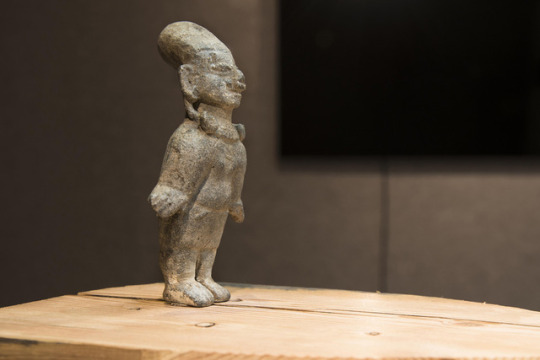




A sneak peek at our upcoming show, Double Portrait. Open January 20 through February 17. Free and open to the public.
Join us for our #reception and #artist talk.
Reception: Saturday, January 20, 7pm
Artist Talk: Monday, January 22, 2:30pm
http://zuccairegallery.stonybrook.edu/2017/12/double-portrait-charley-friedman-and-nancy-friedemann-sanchez/
#charley friedman#nancy friedemann-sanchez#staller center#stallersteps#stony brook university#contemporary art#multimediaart#multimedia#colombia#colombianart#paulwzuccairegallery#zuccaire#gallery#ArtGallery
0 notes
Video
youtube
John Cage: 3 Dances, for two prepared pianos (Ali and Leung)
Performed by Egyptian pianist Seba Ali and Canadian pianist Jacqueline Ching-Ling Leung at the third DMA Recital of Jacqueline Leung. Live performances of John Cage's Three Dances, for two prepared pianos, at the recital hall, Staller Center for the Arts, SUNY-SB, Stony Brook, New York.
13 notes
·
View notes
Text
SPEAKERS' CORNER New Play Development Plays-In-Progress 29-Hour Equity Workshops to Continue
Coming Up: Karma Sutra Chai Tea Latte by Aeneas Hemphill, Directed by Arpita Mukherjee; and There Goes The Neighborhood by Marcus Scott, Directed by Dev Bondarin.
by Chloe Rabinowitz May. 31, 2022
Gingold Theatrical Group, now in its 17th Season, is continuing its new play development with the Plays-In-Progress AEA-approved Showcases of this year's SPEAKER'S CORNER Writers Group. This season, writers Aeneas Sagar Hemphill, Divya Mangwani, Marcus Scott and Mallory Jane Weiss are developing works in response to prompts from the revolutionary activist humanitarian writings and precepts of George Bernard Shaw. These Actors Equity Association approved 29-hour workshops culminate with a presentation as an opportunity for each playwright to assess where they are with their work and to determine the next steps to be taken. These invitation-only presentations will take place at ART-NY Studios (520 8th Avenue). Space for each final presentation is extremely limited and reservations must be made, so to request the opportunity to attend any of these events email [email protected].
This year's final two showcases will be:
There Goes The Neighborhood
by Marcus Scott, Directed by Dev Bondarin
Friday June 3rd at 7pm
Phillip Burke, Savanna Calder, Broderick Clavery, Anthony Godd, Ashley
Jossell, Olivia Kinter, Monique Robinson, Cliff Sellers
Stage Manager: Elliot J. Cohen.
Karma Sutra Chai Tea Latte
by Aeneas Hemphill, Directed by Arpita Mukherjee
Sunday, June 5th at 5pm
Rajesh Bose, Shawn Jain, Mahima Saigal, Salma Shaw, Khyati Sehgal, Imran Sheikh
Assistant Director: Sarah Vishnev
Stage Manager: Elliot J. Cohen
This season's two previous showcases, Vigil-Aunties by Divya Mangwani, directed by Arpita Mukherjee, and Howl From Up High by Mallory Jane Weiss, directed by Lily Riopelle, were held in May.
"Among the many programs we've developed over the last 17 years, developing new plays with the intent to produce and publish, has always been the most ambitious dream of all of us at Gingold. While we continue to produce our annual full Off-Broadway productions of plays by George Bernard Shaw, we plan to add at least one new play to our schedule to share with our devoted patrons," said David Staller.
Named after the corner of London's Hyde Park where George Bernard Shaw and other political speakers have delivered speeches since 1855, GTG's SPEAKERS' CORNER brings together six to ten writers each year who will spend the year exploring a specific Shaw play and writing individual new plays in response to that text and Shaw's forward thinking humanitarian ideals. Speakers' Corner members meet bi-monthly, and GTG will host showings of the works that Speakers' Corner develops at the end of the season. The group's members were identified through an open application process under the guidance of Becker, GTG Artistic Director David Staller, and this season's Speakers' Corner Readers and Advisory Committee: Ilana Becker, Stephen Brown-Fried, Ralph B. Peña, Daphne Rubin-Vega, Sharon Washington, along with Speakers' Corner alumni Hank Kim, and Lorenzo Roberts.
WRITERS:
Aeneas Sagar Hemphill (he/him) is an Indian-American playwright and screenwriter based in NYC and DC. Weaving through many genres, his work builds new worlds to illuminate our own, investigating the ghosts that haunt our lives and communities with passion, pathos, and humor. He was a 2019 Resident Artist with Monson Arts Center and 2017-2018 Playlab fellow at Pipeline Theatre, as well as semi-finalist for the 2019 Princess Grace Award, semi-finalist for the 2019 Mabou Mines Resident Artist Program, and finalist for the 2017 Many Voices Fellowship. His plays include: Black Hollow (Argo Collective, Dreamscape Theatre), The Troll King (Pipeline), Childhood Songs (Monson Arts), The Republic of Janet & Arthur (Amios), The Red Balloon (Noor Theatre), A Stitch Here or There (DarkHorse Dramatists, Slingshot Theatre), A Horse and a Housecat (Slingshot Theatre). MFA Playwriting, Columbia University.
Marcus Scott is a dramatist & journalist. Selected work includes Tumbleweed (finalist for the 2017 Bay Area Playwrights Festival; semifinalist for the 2022 Eugene O'Neill Theater Center National Playwrights Conference, the 2022 Blue Ink Playwriting Award & the 2017 New Dramatists Princess Grace Fellowship Award), Sibling Rivalries (finalist for the 2021 Seven Devils Playwrights Conference; semi-finalist for the 2022 Lanford Wilson New American Play Festival, the 2021 Blue Ink Playwriting Award & the 2021 New Dramatists Princess Grace Fellowship Award) and Cherry Bomb (recipient of the 2017 Drama League First Stage Artist-In-Residence). He was commissioned by Heartbeat Opera to adapt Beethoven's Fidelio (Librettist/Co-writer; The Met Museum; NY Times Critic's Pick). Recently developed at Gingold Theatrical Group (Speaker's Corner), Zoetic Stage (Finstrom Festival Of New Work), Queens Theatre (New American Voices series) and The Road Theatre Company's Under Construction 3 Playwrights Group and Cohort 2 of the Southern Black Playwrights Lab at the Mojoaa Performing Arts Company. Scott is a 2021 NYSAF Founders' Award finalist and a 2021 Doric Wilson Independent Playwright Award semi-finalist. His articles appeared in Architectural Digest, Time Out New York, American Theatre Magazine, Playbill, Elle, Out, Essence, The Brooklyn Rail, among others. MFA: GMTWP, NYU Tisch.
In addition to Speakers' Corner, GTG's on-going play development also includes PRESS CUTTINGS, which, in recognition of Shaw's career as a theatre critic, supports the development of new plays written by theatre journalists. Press Cuttings has commissioned new plays by Jeremy McCarter, Robert Simonson, and David Cote, and, in June of 2017, presented an AEA workshop of David Cote's Otherland directed by May Adrales.
This fall, GTG returned to live, in person performance with the acclaimed revival of Bernard Shaw's Mrs. Warren's Profession starring Robert Cuccioli, David Lee Huynh, Alvin Keith, Nicole King, Raphael Nash Thompson, and Tony® Award winner Karen Ziemba as Mrs. Warren, which recently completed its acclaimed Off-Broadway engagement at Theatre Row, directed by David Staller. Terry Teachout, reviewing Mrs. Warren's Profession in The Wall Street Journal, declared "Mr. Staller, who knows everything there is to know about Shaw, has not only staged the play but edited the text with his accustomed skill. All the more reason, then, to praise David Staller, the artistic director of Project Shaw, a long-running series of semi-staged concert readings of the playwright's 60-odd shows. In addition to Project Shaw, Mr. Staller's Gingold Theatrical Group presented fully staged small-scale off-Broadway versions of Heartbreak House in 2018 and Caesar and Cleopatra in 2019, and now they're doing Mrs. Warren's Profession. The production is completely satisfying... Sprinkled with tart, school-of-Wilde epigrams ('There are no secrets better kept than the secrets everybody guesses') and overflowing with glittering talk, it's a foolproof vehicle for six accomplished actors and a director who, like Mr. Staller, knows better than to let the play become a static chat-fest. Instead, he keeps the actors moving and the pace brisk, and the results are immensely pleasurable."
GINGOLD THEATRICAL GROUP creates theater that supports human rights, freedom of speech, and individual liberty using the work of George Bernard Shaw as our guide. All of GTG's programs are inspired by Shaw's humanitarian values. Through full productions, staged readings, new play development, and inner-city educational programs, GTG brings Shavian precepts to audiences and artists across New York, encouraging individuals to breathe Shaw's humanist ideals into their contributions for the future. Shaw created plays to inspire peaceful discussion and activism and that is what GTG aims to accomplish. GTG's past productions include Man and Superman (2012), You Never Can Tell (2013), Major Barbara (2014), Widowers' Houses (2016), Heartbreak House (2018), and Caesar & Cleopatra (2019). Founded in 2006 by David Staller, GTG has carved a permanent niche for the work of George Bernard Shaw within the social and cultural life of New York City, and, through the Project Shaw reading series, made history in 2009 as the first company ever to present performances of every one of Shaw's 65 plays (including full-length works, one-acts and sketches). GTG brings together performers, critics, students, academics and the general public with the opportunity to explore and perform theatrical work inspired by the humanitarian and activist values that Shaw championed. All comedies, these plays boldly exhibit the insight, wit, passion and all-encompassing socio-political focus that distinguished Shaw as one of the most inventive and incisive writers of all time. Through performances, symposiums, new play development, and outreach, as well as through our discussion groups and partnerships with schools including SUNY Stony Brook, Regis, the De La Salle Academy, and The Broome Street Academy, GTG has helped spark a renewed interest in Shaw across the country, and a bold interest in theater as activism. Young people are particularly inspired by Shaw's invocation to challenge the strictures society imposes, to embrace the power of the individual, to make bold personal choices and to take responsibility for these choices. GTG's new play development lab, Speakers' Corner, created to support playwrights inspired by Shaw's ideals, is now in its second cycle. Through monthly prompts and feedback, writers develop work inspired by or in response to a specific Shaw text. Plays developed through Speakers' Corner will be nurtured in workshops and readings with the expectation that GTG will publish or produce them. GTG encourages all people to rejoice in the possibilities of the future. All of GTG's programming is designed to inspire lively discussion and peaceful activism with issues related to human rights, the freedom of speech, and individual liberty. This was the purpose behind all of Shaw's work and why GTG chose him as the guide toward helping create a more tolerant and inclusive world through the exploration of the Arts.
For more information about the Workshops or any of Gingold Theatrical Group's projects, please call 212-355-7823, email [email protected], or visit online at www.gingoldgroup.org.
#Gingold Theatrical Group#george bernard shaw#Marcus Scott#MarcusScott#WriteMarcus#Write Marcus#Dev Bondarin
0 notes
Text

Omg my last drawing got so many notes in such a small period of time, what is happening to this blog???
WHAT DO YOU MEAN I HAVEN'T POSTED-
Alright, alright. Here. I present to you...
The Phamily.
Consisting of exactly 20 different POTO actors/adaptations/versions.
Let's begin from the oldies, shall we?
Erik from the original Leroux novel - center
Lon Chaney from 1925 silent film
Claude Rains from 1943 movie
Herbert Lom from 1962 movie
Winslow (a.k.a. Birb) from 1974 movie
(M)erik (here - Michael Crawford) from 1986 ALW musical with 9 actors (I would draw each and every one of them, but then there would not be enough space for all of them)
Robert Englund from 1989 movie
(K)erik from 1990 Susan Kay novel
Charles Dance from 1990 miniseries/(Y)erik from Yeston/Kopit 1991 musical
David Staller from Rosen/Schierhorn 1991 musical
Gerard Butler from 2004 movie - on the original's lap
@another-chorus-girl @maestrooftheopera @phantom-of-the-uhhhpera this is for you and the EH server
#phantom of the opera#opera ghost#erik#poto#gerard butler#gerik#poto art#herbert lom#claude rains#professor petrie#erique claudin#winslow#winslow leach#phantom of the paradise#gaston leroux#gaston#susan kay#kerik#lon chaney#lerik#charles dance#cherik#yeston and kopit#rosen and schierhorn#david staller#merik#alw#andrew lloyd webber#michael crawford#babies
298 notes
·
View notes